Thermal comfort is “that condition of mind which expresses satisfaction with the thermal environment”. It is part of a vital survival behavior. Our group decided to see how we could achieve thermal comfort for all in the future through bioclimatic architecture, cooling and ventilation.
I. Bioclimatic Architecture
Bioclimatic architecture aims to achieve thermal comfort for all relying on passive means and adapting to the characteristics of the building location. Therefore, bioclimatic design saves energy and reduces heating and air conditioning expenses.
1. Location and orientation of the building
The location and orientation of a building are determined considering the position of the sun and the direction of prevailing winds.
We try to avoid masks and cast shadow…
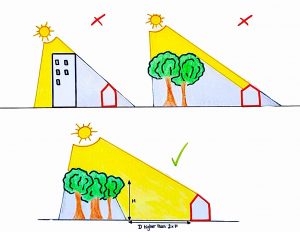
set up the house on the south slope…
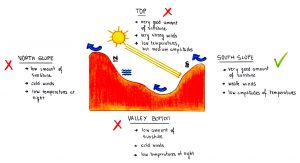
and orient the main facades of the house towards the south.
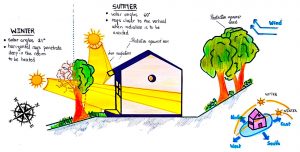
2. Windows
The role and impact of windows vary according to the material used and the building’s properties.
a. Most commonly used materials for the pane
Glass
- the number one choice to insulate windows
- very interesting thermal and sound insulation compared to plexiglass
- very brittle and dangerous composition
Plexiglass
- light transmission coefficient is higher than that of glass
- strength largely superior to that of glass
- higher price, less accessible to everyone
- less thermally insulating than glass, heats up quickly when temperatures increase
b. Most commonly used materials for the frame
Aluminum
- affordability
- easy maintenance
- durability
- conducts a lot of heat and cold
Wood
- very efficient thermal insulation
- longevity
- higher price than other types of windows (PVC, aluminum)
PVC (the most used material, 60% of requests)
- affordability : cheaper than wood and aluminum
- insulating performance in terms of acoustics and heat
- durability
- not very suitable for large windows, such as bay windows
c. Building’s properties
Location: It is better to invest in highly insulating windows if the building is in a country with high or low temperatures.
Orientation: The sun hits the strongest on the southern side. To maintain the same thermal situation within the building, we must improve the insulation of windows that are most exposed to the sun.
Number of windows: Two windows of area A each are not equivalent to a single window of area 2A [cm²]. Energetically, large windows present a lack of efficiency whereas smaller windows allow consequent savings.
Function: On the first hand, very frequented buildings (office, apartment buildings, etc.) must be highly insulated and investing in expensive windows is essential. On the other hand, buildings where people only pass by, buildings where the majority of activities are performed outside (commercial buildings used to stock merchandise, small bungalows) may not be.
3. Compactness and form
The compactness of a building is defined as the ratio of the area of the external envelope and the habitable volume. Lowering this ratio prevents heat loss, and so contributes to achieve thermal comfort efficiently.
The most optimal form for a building is the elongate shape in the East-West direction. It gives the best results of sunshine in winter and minimizes radiations in summer.
4. Interior organization
Knowing thermal needs of each room contributes to achieving thermal comfort.
Here is an example of rationally arranged rooms.
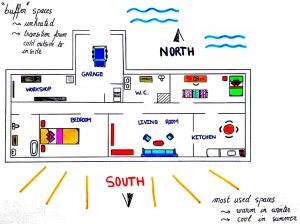
5. Insulation
Insulation provides an effective resistance against heat flows (from warmer to colder places) and also prevents the discomfort of cold walls.
The most important element of the insulation material is:
- for winter comfort : Thermal Resistance R
- for summer comfort : Phase Shift
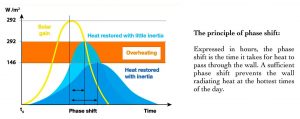
In bioclimatic architecture, the choice of materials is made according to those available nearby. They are particularly suited to the climate and the construction cost will be limited.
- The local stone constructions are adapted to a climate with a strong daily temperature variation.
- The wooden constructions will allow a rapid rise in temperature of the building, particularly suited to climates with severe winters.
- Buildings in mud or sand allow strong solar radiation and increased temperature to be accumulated and thus limit the risk of overheating.
II. Ventilation and Cooling
Heating, ventilation, and air conditioning impact thermal comfort and indoor air quality. HVAC is an important part of residential structures where safe and healthy building conditions are regulated with respect to temperature and humidity, using fresh air from outdoors.
1. Natural Ventilation
Natural ventilation is a common low-cost and a friendly-environmental solution for space conditioning , as building energy consumption and associated negative environmental effects are low. A study in a hawker center in Singapore showed that increasing the roof height, followed by increasing the width of the center passageway drastically are the best variations to improve the cross-ventilation. Moreover, it shows that having openings in the roof may have effects on the natural ventilation as wind tends to channel upwards into the openings rather than flowing.
2. Mechanical Ventilation
In some buildings, natural ventilation is insufficient. Therefore, we use mechanical ventilation provided by an air handler and used to control indoor air quality. Sometimes, controlling airflow in a building under cross-ventilation is a necessity to stay in the comfort zone of thermal comfort. We can achieve this by various methods proven such as :
- An automatic window opening system controlled on the basis of a PMV or by accordance with the temporal variations of indoor and outdoor climates .
- Using CFD analyses to increase the indoor air velocity coupled with tree canopy model.
All of these variables demonstrate the need for a ventilation strategy that can modulate according to the prevailing conditions: increase ventilation rates during periods of high solar and internal gains, and ideally the option to switch to natural ventilation only to achieve high air change rates with no additional energy consumption.
3. The more we cool, the more we heat the planet.
Concrete formation, radiating sunlight and the concentration of people, cars and machinery in the cities pumped out excess heat and greenhouse gas emissions and affected the thermal comfort of citizens! Nowadays, cities are trying to find new ways of cooling.
There are examples from all over the world:
- Following the 2010 heatwave, thanks to Ahmedabd’s plan for cool roofs, awareness raising and cooling stations, India avoided 1,100 deaths per year.
- Melbourne, Australia is working on nature-based solutions by planting 3,000 trees in order to provide shade, reflect sunlight and release moisture into the air through their leaves and cool the city by 4°C.
- Copenhagen, Denmark, uses seawater in its district cooling system and green roofs for municipal buildings, reducing CO₂ emissions by up to 30,000 tonnes per year. The goal is to become CO2-neutral by 2025.
III. The Building of the Futur: Our Vision
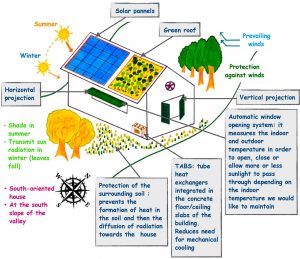
In conclusion, thermal comfort is nowadays an important goal for all developing countries. In order to achieve it, we studied bioclimatic architecture that adapts the outdoor environment of the building and new strategies of ventilation and cooling. Finally, we draw an idea of a future building satisfying thermal comfort.
Ben Mansour Mohamed Ali, Jouhari Sanad, Klim Léa, Tahiri Yasser
*All the drawings were made by us*
References
- CIVIL-212, course of our Professor Dusan Licina
- https://www.sciencedirect.com/topics/engineering/bioclimatic-architecture
- https://www.sciencedirect.com/science/article/pii/S0378778804002476
- http://www.cres.gr/kape/energeia_politis/energeia_politis_bioclimatic_eng.htm
- https://www.somfy.com/common/de/bioclimatic_facades/docs/all.pdf
- https://www.sciencedirect.com/science/article/pii/S036013230900119X
- https://www.irbnet.de/daten/iconda/CIB22300.pdf
- https://eastcoastdesignerbuilders.com.au/green-homes/
- https://www.sciencedirect.com/science/article/pii/S0360132303001124
- https://www.lci.fr/high-tech/video-fenetre-autonome-isolant-plus-fin-a-quoi-ressembleront-nos-maisons-de-demain-salon-construction-et-batiment-2136818.html
- https://www.laprimeenergie.fr/les-travaux/la-fenetre/en-bois
- https://www.mesdepanneurs.fr/blog/fen%C3%AAtres-pvc-quels-sont-les-avantages-et-les-d%C3%A9savantages
- https://fr.wikipedia.org/wiki/Verre
- https://bannerconstruction.com/6-common-window-materials-for-your-home/
- https://www.sciencedirect.com/science/article/pii/S0360132306001193
- https://www.unenvironment.org/news-and-stories/story/cities-can-fight-climate-change-and-improve-lives-finding-new-ways-be-cool